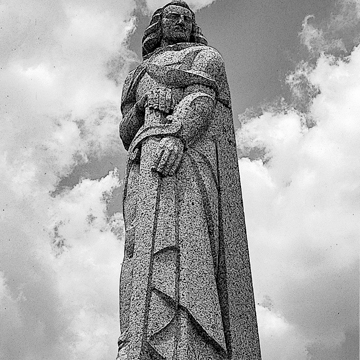The standing figure of seventeenth-century French explorer Cavelier de La Salle is a stunning example of Art Deco sculpture, all the more surprising for its isolated location on the shore of Matagorda Bay. Sculptor Josset, with carver Lavaggi and architect Nelson, all of whom had worked at the Texas Centennial Exposition of 1936 in Dallas, fashioned the twenty-two-foot-high figure of Kings land pink granite. It rises from a narrow, parallelogram-shaped pedestal atop a blocky base. By keeping the detail simple and the figure contained, Josset and Lavaggi ensured that it could survive the natural hazards to which its extremely exposed position renders it vulnerable.
Cavelier de La Salle was the French adventurer and explorer who in 1682 became the first European to descend the Mississippi River to its mouth and then publicize this discovery. In 1684 he led an expedition from France to establish a civil colony near the mouth of the Mississippi. His convoy of ships miscalculated and arrived instead off the coast of Spanish Texas, entering Matagorda Bay through Pass Cavallo in early 1685. La Salle established a settlement on Garcitas Creek: Fort St. Louis, his base for overland expeditions to locate the Mississippi. His ineptness and arrogance led one of his men to kill him in 1687. Although a number of expedition participants made the overland trek from Matagorda Bay to Canada, the French settlers who remained at Fort St. Louis were killed by indigenous people in retaliation for La Salle's hostile acts. Spanish officials in Mexico, learning of the French incursion in their territory, sent an expeditionary force along the Texas coast in 1689, led by Alonso de León, that discovered the ruins of Fort St. Louis and the remains of its French settlers. A member of de León's party, Franciscan priest Damián Massanet, was instrumental in promoting the settlement pattern of Franciscan missions and Spanish presidios by which the Audiencia de México, at the end of the seventeenth century, sought to introduce a Spanish presence into Texas to secure it against further French incursion.
Historians in the nineteenth and twentieth centuries speculated on the possible sites of Fort St. Louis. Two archaeological discoveries in the 1990s uncovered the key sites and artifacts associated with La Salle's expedition. In 1995–1997, the Texas Historical Commission excavated La Belle, one of La Salle's four ships, which sank in Matagorda Bay in a storm in 1686. The hull of the ship and her contents—a wide range of artifacts brought from France to sustain daily life—were excavated from beneath the silt of the bay, an excellent preservative that kept even fabrics and fibers intact. In 1996, an amateur archaeologist discovered the eight French cannons that the Spanish found at Fort St. Louis and made a record of burying in 1689. Between 1997 and 2002, the Texas Historical Commission conducted an excavation of the site, locating both the French settlement and the subsequent Spanish military post.

